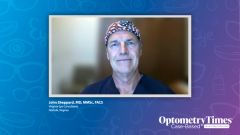
Patient Case No. 2: Managing Evaporative Dry Eye Without Relying on Artificial Tears
John Sheppard, MD, reviews the case of a 63-year-old male with evaporative dry eye, facing challenges in managing his symptoms using over-the-counter artificial tears.
John Sheppard, MD: Our second case is about a [patient] who ran over his cat, most alarming because most of us like our pets, and most of us become alarmed when we can’t see where we’re driving. This is a 63-year-old Hispanic [man] who’s an executive, an avid surfer, and a golf champion. He used to smoke 2 packs of cigarettes a day, but no longer does so. He had childhood acne. He enjoys fried foods, but not alcohol. And unfortunately, he has an elevated [body mass index] of 27, a risk factor for various ocular diseases, including dry eye. He has an intense work and travel schedule. He has sleep apnea. He uses CPAP. He’s on lovastatin for hypercholesterolemia and takes coenzyme Q10. He uses generic artificial tears every 2 hours. His acuity in a controlled environment in the ophthalmic examination lane is 20/40, but his glare increases to 20/200 when tested specifically for those disabilities that give us challenges with night driving. He has 2 plus nuclear sclerosis in both eyes, explaining his glare disability. So let’s take a look at his topography. The curvature looks OK in the right eye. He doesn‘t have too much astigmatism and some minor higher-order aberrations.
However, when we examine the lid margin, we see that his glands are missing or inspissated. This is advanced meibomian gland disease. We also noticed some excrescences on the lashes as well, which could be collarettes, it could be bacterial, it could be Demodex, it could be all. Let‘s look at the left eye. Here we see a superior island of steepening. We see some higher-order astigmatic changes, as well as some aberrations. If we look at the slit lamp, we see negative staining patterns indicative of anterior basement membrane dystrophy, and this the right eye with a relatively normal topography.
However, in the left eye, we see a more extensive superior topographic change that is manifested by these negative staining patterns on a large area of basement membrane dystrophy, bordering the pupillary margin, which explains that steepening on the topographic analysis. This is unacceptable for corneal testing prior to cataract surgery calibration. In addition, we obtained a meibography. We see that he‘s missing about a third of his meibomian gland architecture. This is the right eye. In the left eye, we see a very similar pattern. This is not normal. It may be commensurate with the average 65-year-old, but at the same time, it is not acceptable. Patients respond to meibography. He will say, “Oh, how can I improve this? “And I will say, “You cannot. You only get so many meibomian glands at birth.” And thus we want to arrest this process. Indeed, he will be motivated to handle his evaporatively driven and most likely hyposecretory dry eye disease prior to cataract surgery, biometry, and then the operating room.
Transcript is AI-generated and edited for clarity and readability.
Newsletter
Want more insights like this? Subscribe to Optometry Times and get clinical pearls and practice tips delivered straight to your inbox.



















































.png)


